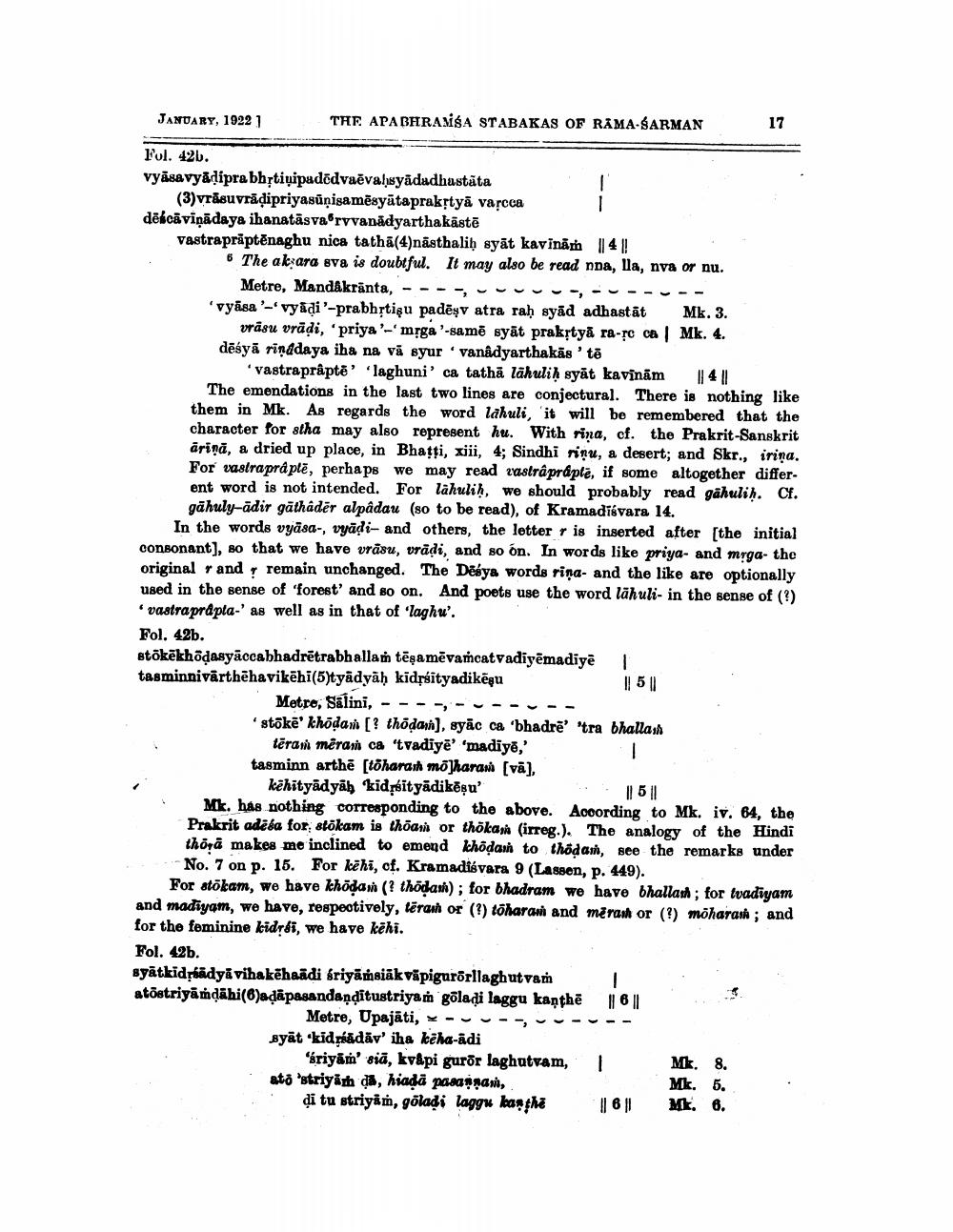________________
JANUARY, 1922]
Fol. 42b.
THE APABHRAMSA STABAKAS OF RAMA-SARMAN
vyasavy&prabhṛtiņipadõdvaěvalayadadhastāta
1
(3)vrieripriyasüṇisamēayātaprakṛtyä vapeca delcäviädaya ihanatäsvarvvanadyarthakästä
vastraprāptēnaghu nica tatha(4)nasthaliḥ syat kavinam ||4|!
6 The aksara sva is doubtful. It may also be read nna, lla, nva or nu. Metre, Mandakrānta,
'vyasa'-' vyaḍi'-prabhṛtisu padeṣv atra raḥ syad adhastat
vrāsu vrādi, 'priya '-' mrga '-same syāt prakṛtya ra-re ca| desya rinddaya iha na va syur vanâdyarthakas' tē
||4||
'vastraprâpte' laghuni' ca tatha lähuliḥ syat kavinām The emendations in the last two lines are conjectural. There is nothing like them in Mk. As regards the word lahuli, it will be remembered that the character for stha may also represent hu. With rina, cf. the Prakrit-Sanskrit āriņā, a dried up place, in Bhatti, xiii, 4; Sindhi rinu, a desert; and Skr., irina. For vastraprâple, perhaps we may read vastrâprapte, if some altogether different word is not intended. For lahuliḥ, we should probably read gähuliḥ. Cf. gahuly-adir gäthâder alpâdau (so to be read), of Kramadiévara 14.
In the words vyāsa-, vyaḍi- and others, the letter r is inserted after [the initial consonant], so that we have vrasu, vrādi, and so on. In words like priya- and mrga- the original r and remain unchanged. The Desya words rina- and the like are optionally used in the sense of 'forest' and so on. And poets use the word lähuli- in the sense of (?) vastraprapta-' as well as in that of 'laghu'.
Fol. 42b.
stōkekhöjayaccabhadrětrabhallam tegamevamcatvadiyèmadiyê tasminnivarthēhavikehi(5)tyädyäḥ kidṛśityadikēsu
Metre, Silini,
'stōke' khōdam [? thōdan], syac ca 'bhadre' 'tra bhallah teram mēram ca "tvadiye' 'madiye,'
I
tasminn arthe [tōharam mo]haram [vā],
Fol. 42b.
syātkiddyä vihakëhaādi iriyäṁalāk vīpigurðrllaghutvaṁ atōetriyähähi(6)aḍāpasandaṇḍitustriyam gülaḍi laggu ka thë
Metre, Upajati,
syat 'kidṛśādāv' iha keha-ādi
'ariyam' sia, kvapi gurōr laghutvam,
kehityādāḥ kid♫ityādīkēņu'
|| 5 ||
Mk. has nothing corresponding to the above. According to Mk. iv. 64, the Prakrit adeta for stökam is thōam or thōka (irreg.). The analogy of the Hindi thora makes me inclined to emend khodam to thodam, see the remarks under No. 7 on p. 15. For kehi, cf. Kramadisvara 9 (Lassen, p. 449).
For stōkam, we have khodam (? thōdash); for bhadram we have bhallamh; for tvadiyam and madiyam, we have, respectively, terash or (?) toharam and mêrash or (?) moharam; and for the feminine kidṛéi, we have kěhi.
ato 'striyam da, hiada pasannam,
1
i tu stryk, gõladi laggu kanth
||5||
I
1
|| 6 ||
Mk. 3.
Mk. 4.
|| 6 ||
17
Mk. 8.
Mk. 5.
Mk. 6.




